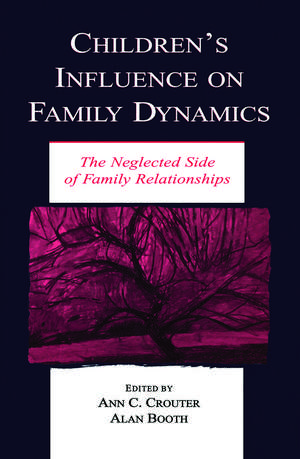Children's Influence on Family Dynamics: The Neglected Side of Family Relationships: Penn State University Family Issues Symposia Series
Editat de Ann C. Crouter, Alan Boothen Limba Engleză Paperback – 9 iul 2013
The volume is based on the presentations and discussions from a national symposium on "Children's influence on family dynamics: The neglected side of family relationships" held at the Pennsylvania State University, as the ninth in a series of annual interdisciplinary symposia focused on family issues. It is divided into four parts, each dealing with a different aspect of the topic. Part I sets the stage by focusing on the features of children that make a difference, as well as the kinds of research designs that are likely to shed light on the role of child influences. Part II focuses on early childhood, particularly the role of infant temperament and other individual differences in very young children in shaping their parents' behaviors, reactions in turn that feedback and influence the developing child. Part III focuses on adolescence, a time when young people are able to exert more choice in how they spend their time and who they spend it with. Part IV pulls the themes of the volume together and points the way for future research.
Preț: 350.29 lei
Preț vechi: 378.77 lei
-8% Nou
Puncte Express: 525
Preț estimativ în valută:
67.03€ • 69.59$ • 55.90£
67.03€ • 69.59$ • 55.90£
Carte tipărită la comandă
Livrare economică 24 martie-07 aprilie
Preluare comenzi: 021 569.72.76
Specificații
ISBN-13: 9780415646536
ISBN-10: 0415646537
Pagini: 280
Dimensiuni: 152 x 229 x 228 mm
Greutate: 0.41 kg
Ediția:1
Editura: Taylor & Francis
Colecția Routledge
Seria Penn State University Family Issues Symposia Series
Locul publicării:Oxford, United Kingdom
ISBN-10: 0415646537
Pagini: 280
Dimensiuni: 152 x 229 x 228 mm
Greutate: 0.41 kg
Ediția:1
Editura: Taylor & Francis
Colecția Routledge
Seria Penn State University Family Issues Symposia Series
Locul publicării:Oxford, United Kingdom
Public țintă
ProfessionalCuprins
Contents: Preface. Part I: What Features of Children Shape Family Relationships and How? D. Reiss, Child Effects on Family Systems: Behavioral Genetic Strategies. K. McCartney, On the Meaning of Models: A Signal Amidst the Noise. X. Ge, M.B. Donnellan, L. Harper, Are We Finally Ready to Move Beyond "Nature vs. Nurture"? J.R. Udry, How to Spin Straw Into Gold. Part II: What Role Does Infant and Early Childhood Temperament Play in the Development of Relationship With Parents? S. Crockenberg, E. Leerkes, Infant Negative Emotionality, Caregiving, and Family Relationships. C.A. Stifter, Child Effects on the Family: An Example of the Extreme Case and a Question of Methodology. J.P. McHale, K.C. Kavanaugh, J.M. Berkman, Sensitivity to Infants' Cues: As Much a Mandate for Researchers as for Parents. P.M. Cole, The Developmental Course From Child Effects to Child Effectiveness. Part III: What Roles Do Adolescents Play in Actively Shaping Relationships With Parents, Siblings, and Peers? M. Kerr, H. Stattin, Parenting of Adolescents: Action or Reaction? E.G. Menaghan, On the Brink: Stability and Change in Parent-Child Relations in Adolescence. G.H. Brody, Parental Monitoring: Action and Reaction. D.M. Capaldi, Parental Monitoring: A Person-Environment Interaction Perspective on This Key Parenting Skill. M. Kerr, H. Stattin, Straw Men, Untested Assumptions, and Bi-directional Models: A Response to Capaldi and Brody. Part IV: How Do Children Affect Parents' Marriage and Other Family Relationships? E.E. Maccoby, The Gender of Child and Parent as Factors in Family Dynamics. S.M. McHale, A.C. Crouter, How Do Children Exert an Impact on Family Life? H. Stattin, M. Kerr, Eleanor E. Maccoby on the Active Child: Gender Differences and Family Interactions. E.E. Maccoby, Reply to Stattin--Kerr Critique. N.R. Crick, A Gender-Balanced Approach to the Study of Childhood Aggression and Reciprocal Family Influences. L. Shanahan, J.M. Sobolewski, Child Effects as Family Process.
Descriere
The topics of the symposia are timely and of significant interest to family researchers. This book focuses on the importance of the differences found among siblings and how they influence interactions between members of the family and behavior outside th





















